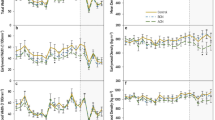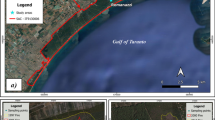Abstract
Narrow-leaved ash (NLA) has a wide natural distribution with ecologically different areas; however, in Sakarya, Turkey, the bottomland forests are now mostly dominated by pure NLA plantations. In this study, two thinning experiments were carried out in 22- and 36-year-old NLA plantations in Sakarya in order to determine the effects of different thinning intensity (unthinned or the control, removal of 22.3 and 39.4% of the basal area) on mean diameter, basal area and volume growth of the whole stand, those of the 100 largest trees in the stand and trees of initial diameter size class after 10 years. A randomized block design with three replications was used in both experiments. Ten-year results of selective low thinning treatments indicated that thinning significantly increased diameter increments, which were positively correlated with the thinning intensity in both plantations when compared to the control. Heavy thinning increased the increment of mean stand diameter but did not significantly affect the basal area or volume of the stand in either of the experiments. However, in the first experiment, basal area and volume increments differed significantly among treatments, increasing with thinning intensity for the 100 largest trees. In the second experiment, although not statistically significant, the basal area and volume increments also increased with thinning intensity for the 100 largest trees. Moreover, all measured increments were higher in the younger plantation than in the older. These results showed that different thinning intensities applied in NLA plantations can produce similar basal area and volume increments. Consequently, to maximize diameter growth and increase crop tree value, heavy thinning treatments can be recommended, particularly for young NLA plantations at bottomland sites.

Similar content being viewed by others
References
Bobinac M (2000) Effect of late thinning on the increment of future trees of narrow-leaved ash (Fraxinus angustifolia Vahl). Glasnik Šumarskog fakulteta 83:43–54
Boncina A, Kadunc A, Robic D (2007) Effects of selective thinning on growth and development of beech (Fagus sylvatica L.) forest stands in south-eastern Slovenia. Ann For Sci 64:47–57. https://doi.org/10.1051/forest:2006087
Boshier D et al (2005) Ash species in Europe: biological characteristics and practical guidelines for sustainable use. Oxford Forestry Institute, University of Oxford. doi:citeulike-article-id:13130220
Bréda N, Granier A, Aussenac G (1995) Effects of thinning on soil and tree water relations, transpiration and growth in an oak forest (Quercus petraea (Matt.) Liebl.). Tree Physiol 15:295–306. https://doi.org/10.1093/treephys/15.5.295
Cameron AD, Dunham RA, Petty JA (1995) The effects of heavy thinning on stem quality and timber properties of silver birch (Betula pendula Roth). Forestry 68:275–286. https://doi.org/10.1093/forestry/68.3.275
Cañellas I, Río MD, Roig S, Montero G (2004) Growth response to thinning in Quercus pyrenaica Willd. coppice stands in Spanish central mountain. Ann For Sci 61:243–250
Carus S, Çiçek E (2007) A diameter increment model for individual trees of ash (Fraxinus angustifolia Vahl.) plantations in Adapazarı-Süleymaniye Region. Süleyman Demirel Univ Fac For J 1:34–48
Çiçek E, Yilmaz M (2002) The importance of Fraxinus angustifolia subsp. oxycarpa as a fast growing tree for Turkey. In: Diner A (ed) IUFRO meeting on management of fast growing plantations, İzmit, Turkey, pp 11–13
Çiçek E, Yılmaz M, Yılmaz F, Usta A (2010) Effects of thinning on growth and some soil properties in narrow-leaved ash (Fraxinus angustifolia) plantations. Project Report, TÜBİTAK TOVAG 105O519. Düzce, Turkey
Çiçek E, Yılmaz F, Özbayram AK, Çitgez T (2012) Effect of thinning intensity and crown class on narrow-leaved ash (Fraxinus angustifolia Vahl.) Epicormic Branching. Artvin Çoruh Univ J For Fac 13:40–48
Cicek E, Yilmaz F, Özbayram AK, Efe M, Yilmaz M, Usta A (2013) Effects of thinning intensity on the growth of narrow-leaved ash (Fraxinus angustifolia subsp. oxycarpa) plantations. Turk J Agric For 37:97–104
Clatterbuck WK (2002) Growth of a 30-year cherrybark oak plantation 6 years after thinning. In: Outcalt K (ed) Proceedings of the eleventh biennial southern silvicultural research conference, Asheville, 2002. USDA For Ser Southern Research Station, pp 189–192
Dobrowolska D, Hein S, Oosterbaan A, Wagner S, Clark J, Skovsgaard JP (2011) A review of European ash (Fraxinus excelsior L.): implications for silviculture. Forestry. https://doi.org/10.1093/forestry/cpr001
Ducrey M, Toth J (1992) Effect of cleaning and thinning on height growth and girth increment in holm oak coppices (Quercus ilex L.). In: Romane F, Terradas J (eds) Quercus ilex L. ecosystems: function, dynamics and management. Springer Netherlands, Dordrecht, p 365. https://doi.org/10.1007/978-94-017-2836-2_38
Hibbs DE, Emmingham WH, Bondi MC (1989) Thinning red alder: effects of method and spacing. For Sci 35:16–29
Hibbs DE, Emmingham WH, Bondi MC (1995) Responses of red alder to thinning. West J Appl For 10:17–23
Howell M, Nix LE (2002) Early thinning in bottomland hardwoods. Gen Tech Rep SRS-48 Asheville, NC: USDA, Forest Service, Southern Research Station, pp 196–200
Juodvalkis A, Kairiukstis L, Vasiliauskas R (2005) Effects of thinning on growth of six tree species in north-temperate forests of Lithuania. Eur J For Res 124:187–192. https://doi.org/10.1007/s10342-005-0070-x
Kapucu F, Yavuz H, Gül A (1999) Normal yield tables for natural and artificial ash (Fraxinus angustifolia) stands (in Turkish with English abstract). Project Report, Karadeniz Technical University 96.113.001.4. Trabzon
Kerr G (1996) The effect of heavy or ‘free growth’ thinning on oak (Quercus petraea and Q. robur). Forestry 69:303–317. https://doi.org/10.1093/forestry/69.4.303
Kozlowski T, Pallardy S (1997) Physiology of woody plants, 2nd edn. Academic Press, San Diego
Kremer D, Cavlovic J, Bozic M (2006) Growth characteristics of introduced green ash (Fraxinus pennsylvanica Marshall) and narrow-leaved ash (F. angustifolia L.) in Lowland Forest Region in Croatia. New For 31:211–224. https://doi.org/10.1007/s11056-005-5176-y
Kuehne C, Kublin E, Pyttel P, Bauhus J (2013) Growth and form of Quercus robur and Fraxinus excelsior respond distinctly different to initial growing space: results from 24-year-old Nelder experiments. J For Res 24:1–14. https://doi.org/10.1007/s11676-013-0320-6
Leak WB, Solomon DS (1997) Long-term growth of crop trees after release in northern hardwoods. North J Appl For 14:147–151
Makineci E (2005) Thinning effects on diameter increment and some soil properties in sessile oak (Quercus petrea (Matlusch) Liebl.) coppice forest. Süleyman Demirel Univ Fac For J 2:1–10
Mayor X, Rodà F (1993) Growth response of holm oak (Quercus ilex L) to commercial thinning in the Montseny mountains (NE Spain). Ann For Sci 50:247–256
Meadows JS (1995) Epicormic branches and lumber grade of bottomland oak. In: Lowery G, Meyer D (eds) Proc of the 23rd ann harwood symposium, Memphis, 1995. National Harwood Lumber Association, pp 19–25
Meadows J, Goelz J (2002) Fourth year effects of thinning on growth and epicormic branching in a red oak-sweetgum stand on a minor stream bottom site in West-Central Alabama. In: Outcalt K (ed) Eleventh biennial southern silvicultural research conference, Asheville-NC, 2002. USDA For Ser, Gen Tech Rep SRS–48, pp 201–208
Medhurst JL, Beadle CL, Neilsen WA (2001) Early-age and later-age thinning affects growth, dominance, and intraspecific competition in Eucalyptus nitens plantations. Can J For Res 31:187–197. https://doi.org/10.1139/x00-163
Miller GW (1997) Stand dynamics in 60-year-old Allegheny hardwoods after thinning. Can J For Res 27:1645–1657. https://doi.org/10.1139/x97-134
Nowak CA (1996) Wood volume increment in thinned, 50- to 55-year-old, mixed-species Allegheny hardwoods. Can J For Res 26:819–835. https://doi.org/10.1139/x26-091
OGM (2004) Hendek Forest District, Süleymaniye Forest Management Plan. General Directorate of Forestry, Ankara
Oliver CD, Larson BC (1996) Forest stand dynamics. Update edn, Wiley Hoboken
Özbayram AK (2014) Effect of thinning intensity on the growth of oriental beech (Fagus orientalis Lispky) stands in Duzce. PhD thesis, Duzce University
Pothier D, Margolis A (1991) Analysis of growth and light interception of balsam fir and white birch saplings following precommercial thinning. Ann For Sci 48:123–132
Pretzsch H (2005) Stand density and growth of Norway spruce (Picea abies (L.) Karst.) and European beech (Fagus sylvatica L.): evidence from long-term experimental plots. Eur J For Res 124:193–205. https://doi.org/10.1007/s10342-005-0068-4
Rytter L (1995) Effects of thinning on the obtainable biomass, stand density, and tree diameters of intensively grown grey alder plantations. For Ecol Manag 73:135–143
Rytter L, Werner M (2007) Influence of early thinning in broadleaved stands on development of remaining stems. Scand J For Res 22:198–210. https://doi.org/10.1080/02827580701233494
Savill PS (1991) The silviculture of trees used in British forestry. CABI, Wallingford
Savill P, Evans J, Auclair D, Falck J (1997) Plantation silviculture in Europe. Oxford University Press, NewYork
Schönau APG, Coetzee J (1989) Initial spacing, stand density and thinning in eucalypt plantations. For Ecol Manag 29:245–266. https://doi.org/10.1016/0378-1127(89)90097-2
Şentürk N (1998) Construction of stem and tree volume tables for ash. Master's thesis, Karadeniz Technical University, Turkey
Sharma M, Smith M, Burkhart HE, Amateis RL (2006) Modeling the impact of thinning on height development of dominant and codominant loblolly pine trees. Ann For Sci 63:349–354
Simard SW, Blenner-Hassett T, Cameron IR (2004) Pre-commercial thinning effects on growth, yield and mortality in even-aged paper birch stands in British Columbia. For Ecol Manag 190:163–178. https://doi.org/10.1016/j.foreco.2003.09.010
Smith DM, Larson BC, Kelty MJ, Ashton PMS (1997) The practice of silviculture: applied forest ecology, 9th edn. Wiley, Hoboken
Tüfekçioğlu A, Güner S, Tilki F (2005) Thinning effects on production, root biomass and some soil properties in a young oriental beech stand in Artvin. Turk J Environ Biol 26:91–95
Wang JR, Simard SW, Kimmins JP (1995) Physiological responses of paper birch to thinning in British Columbia. For Ecol Manag 73:177–184. https://doi.org/10.1016/0378-1127(94)03489-J
Yaltırık F (1978) Taxonomic revision of the indigenous taxa within the family oleaceae in Turkey. Public. no. 2404/250. Faculty of Forestry Istanbul University, Çelikcilt Press, Istanbul
Author information
Authors and Affiliations
Corresponding author
Rights and permissions
About this article
Cite this article
Özbayram, A.K., Çiçek, E. Thinning experiments in narrow-leaved ash (Fraxinus angustifolia Vahl.) plantations: 10-year results. New Forests 49, 585–598 (2018). https://doi.org/10.1007/s11056-018-9642-8
Received:
Accepted:
Published:
Issue Date:
DOI: https://doi.org/10.1007/s11056-018-9642-8




